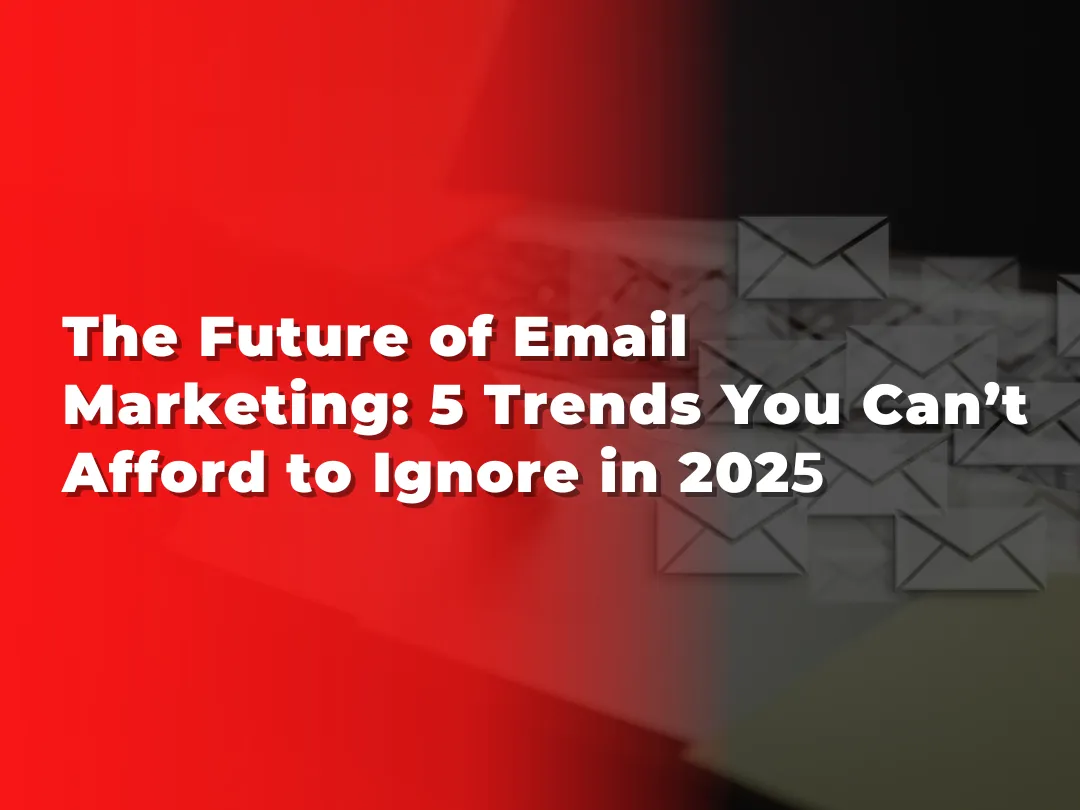Insights & Strategies
Elite Marketing Authority Blog
Stay Ahead with the Latest Trends in Digital Marketing

The Future of Email Marketing: 5 Trends You Can’t Afford to Ignore in 2025
Email marketing remains one of the most powerful tools in digital marketing, offering a high ROI when done right. But to stay effective, email marketing strategies need to evolve with changing consumer behavior and technology. As we approach 2025, several new trends are shaping how businesses should approach email marketing. To help you stay competitive, we've identified the top five email marketing trends for 2025 that will take your campaigns to the next level. From AI-driven personalization to privacy-centric practices, here’s everything you need to know to stay ahead.
1. AI-Driven Personalization
In 2025, personalization in email marketing is advancing thanks to artificial intelligence (AI). No longer limited to using the recipient’s first name, AI now allows businesses to create hyper-personalized content tailored to individual customer behavior and preferences.
Why AI-Powered Personalization Matters: AI helps analyze customer data in real-time, enabling businesses to predict and recommend products or content that a recipient is most likely to engage with. This data-driven approach allows marketers to send dynamic emails that change based on the user’s interaction history, driving higher email open rates and conversions.
Micro-Segmentation with AI: AI enables highly targeted segmentation by analyzing behavioral data such as browsing habits, purchase history, and engagement patterns. This micro-segmentation helps deliver personalized offers and content that feel tailor-made for each customer, increasing customer retention and engagement.
Example: Retailers can use AI-powered tools like Phrasee to automatically generate subject lines optimized for higher open rates, or leverage predictive analytics to recommend products that a user is most likely to buy. Personalization at this level boosts email marketing ROI and strengthens customer relationships.
2. Interactive Emails
Static emails are no longer enough to capture attention. In 2025, interactive emails will dominate, offering users an engaging and seamless experience without ever leaving the inbox.
Why Interactive Content Boosts Engagement: Emails that include interactive elements such as surveys, carousels, polls, or even embedded video content allow users to interact directly within the email. This reduces friction, making it easier for recipients to engage, leading to higher click-through rates (CTR) and better overall engagement.
AMP for Email: AMP technology enables emails to act more like web pages, allowing recipients to book appointments, browse products, or even make purchases without leaving their email client. This innovation not only improves the user experience but also streamlines the buyer’s journey. You can read more about AMP for email and how it enhances email campaigns.
Example: A travel company could embed a flight search tool within the email, while an eCommerce brand could create interactive product galleries. These interactive emails increase engagement and conversion rates by making it easier for users to take action.
3. Privacy-Centric Email Marketing
With the increasing focus on data privacy and stricter regulations like GDPR and CCPA, 2025 will see a rise in privacy-centric email marketing. Consumers are becoming more concerned with how their data is used, and marketers need to prioritize transparency and compliance.
The Shift to First-Party Data: As third-party cookies become obsolete, brands must rely on first-party data (information collected directly from customers) for personalized email marketing. This shift emphasizes the need for ethical data collection practices and more transparent relationships with customers.
Building Trust with Transparency: Businesses that communicate openly about how they use customer data will build stronger trust with their audience. Make sure your emails include clear information about how data is being used and allow users to easily manage their preferences and consent.
Example: Brands like Apple have set high standards for privacy-conscious email marketing. By including clear opt-ins, providing transparent privacy policies, and offering control over personal data, you can build trust with your subscribers and improve customer loyalty while staying compliant with data regulations.
4. Omnichannel Integration
The days of siloed email marketing campaigns are over. In 2025, omnichannel marketing will be crucial for delivering a consistent and seamless customer experience. Email will no longer be a standalone channel but part of an integrated approach that includes SMS, social media, and even direct mail.
Why Omnichannel Matters in 2025: Customers expect a cohesive brand experience across multiple touchpoints. Whether they’re interacting with your business through email, SMS, or social media, an integrated strategy ensures that your message is consistent and relevant. Omnichannel email marketing allows you to connect with customers wherever they are, driving better engagement and brand loyalty.
Automation for Omnichannel Marketing: Using platforms like HubSpot or Klaviyo, you can automate workflows that deliver a unified message across multiple channels. For instance, if a customer doesn’t open your email, you can follow up with an SMS or target them with a retargeting ad on social media, ensuring your message gets through.
Example: A retail brand might send a promotional email about a sale, followed by a reminder via SMS, and then show retargeting ads on Instagram for those who clicked the email but didn’t complete a purchase. This multi-channel approach reinforces your message and helps boost conversions by meeting customers on their preferred platform.
5. Sustainable and Ethical Email Practices
As consumers become more socially and environmentally conscious, 2025 will see a surge in sustainable and ethical email marketing practices. Aligning with these values can help brands attract a loyal customer base that cares about sustainability and ethics.
Eco-Friendly Emails for a Greener Future: Even digital activities like sending emails have a carbon footprint. In 2025, brands that focus on sustainable email marketing practices—like reducing the file size of images, minimizing unnecessary data, and designing cleaner email templates—will not only contribute to environmental efforts but also appeal to eco-conscious customers.
Ethical Marketing Practices: Ethical email marketing goes beyond sustainability. It means being transparent in your messaging, avoiding manipulative tactics like fake urgency, and ensuring your content is inclusive and socially responsible. Brands that demonstrate ethical behavior in their marketing are more likely to earn long-term customer trust.
Example: Companies like Patagonia have successfully integrated sustainability into their email marketing, showcasing their eco-friendly initiatives and encouraging responsible consumer behavior. By promoting your brand’s environmental efforts and ethical values in your emails, you can resonate with consumers who prioritize these aspects when making purchasing decisions.
2025 is shaping up to be an exciting year for email marketing, with trends like AI-driven personalization, interactive content, privacy-focused strategies, omnichannel integration, and sustainable practices leading the way. By adopting these cutting-edge strategies, you can create email campaigns that not only drive engagement but also foster stronger customer relationships and loyalty. Start implementing these trends now to ensure your email marketing remains relevant, effective, and future-proof.
Want to stay ahead of the curve in email marketing? Subscribe to Elite Marketing Authority for the latest tips, trends, and strategies to make your campaigns more effective than ever!






